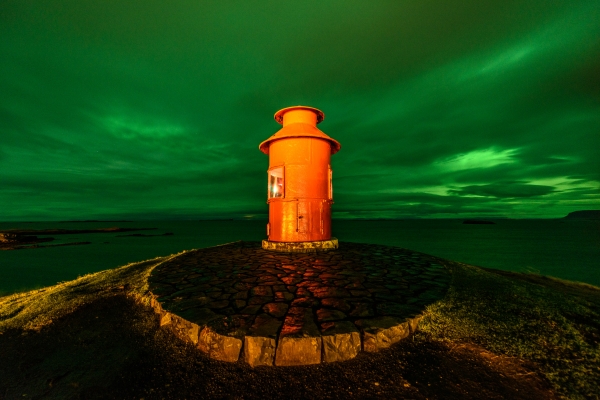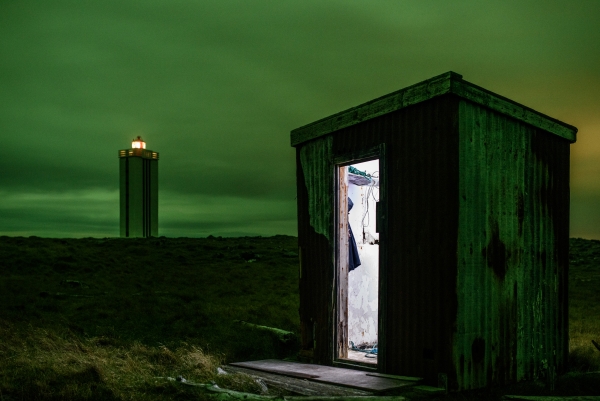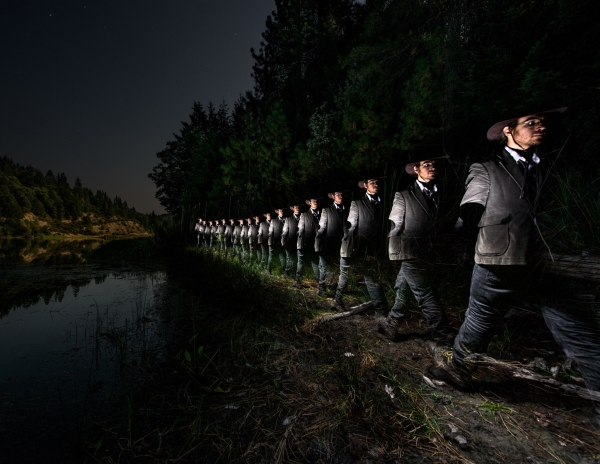American photographer Justin Benttinen quit his job at a rare book auction house to dedicate himself to work on a project he hopes will show that one person can try and make a difference in a sea of billions of people. He began his work at the foot of the foot of the Lyell glacier in Yosemite National Park last year and arrived in Iceland on October, his first stop, travelling around the globe.
“I am starting work on a project to document things that are disappearing from climate change and human activity,” he explains and adds, “The aim is to create books of the photos designed to last a thousand years so that people of the future can know what we were like even if industrial civilization has a setback for 50 or a 100 years and all of our digital files are lost.”
Benttinen’s project is called Goodbye My Holocene Dream, and he has launched a basic website outlining it at holocenedream.com.
“My first test run of the project was on my birthday last year, when I climbed to the foot of the Lyell Glacier (almost 4,000 m/13,123 ft) in Yosemite National Park to photograph it under the light of a supermoon. I chose this as my first place to test this idea out as it is some of the last remaining blue ice in Yosemite National Park and will probably cease to exist within the next 20 to 30 years,” says Benttinen.
 Lyell Glacier Pictured in supermoon Yosemite National Park, California. Photo/Justin Benttinen
Lyell Glacier Pictured in supermoon Yosemite National Park, California. Photo/Justin BenttinenRegarding the name of the project he explains that the holocene epoch has served as the cradle of human civilization, creating perfect conditions for us to become a global society.
“It is up to us to determine whether we use the environmental and cultural sacrifices we have made along the way for good and propel our species to the stars or whether we devolve inward and waste this most amazing opportunity. Either way, I am dedicating my life to documenting what happens in this pivotal time for the people of the far future.”
In Iceland Benttinen is focusing on the glaciers, which cover about 11% of the country’s 103.000 square kilometers (39.768 sq mi). Scientists have predicted that they may disappear within the next 100 to 150 years if current trends of climate change are not reversed.
Read more: A guide to Iceland’s glaciers, what to do there & their claim to fame
“I did some work on it yesterday at Fláajökull glacier, creating a gigantic panorama of the glacier tongue. If printed at high resolution it would be more than two meters (6.5 ft) in width.”

Benttinen is originally from the state of Rhode Island on the East Coast of the US, but moved years ago to San Francisco on the West Coast. His family name comes from his grandfather who was a full-blooded Finn.
But why did he leave his work and start this huge mission alone?
“I intend it partially to show that one person can try and make a difference in a sea of billions of people. So to that end my project is both about how we as individuals can do something about climate change as well as being about creating memories of our time for the future.”
Benttinen explains that he is still forming the schedule for the things he wants to capture.
“But I am definitely interested in making ice an important part of my work. I think that equatorial ice, such as that found on the Rwenzori mountains on the border of the Democratic Republic of the Congo and Uganda would be a very important choice as this might be gone within a few decades. So volume one very well could be ice of the equator.”
And he is into this for the long-haul.
“I am thinking that I could try my best to make this a lifelong endeavor, with each volume a different series, such as traditional cultures, plants and animals, and coastal landscapes. With sea level rise there will be a lot of built environments that will disappear, and I think it is imperative to let the people of future millennia know what world we lived in.”

 At the northernmost point of mainland Iceland Hraunhafnartangi lighthouse and shed. Photo/Justin Benttinen
At the northernmost point of mainland Iceland Hraunhafnartangi lighthouse and shed. Photo/Justin Benttinen

American photographer Justin Benttinen quit his job at a rare book auction house to dedicate himself to work on a project he hopes will show that one person can try and make a difference in a sea of billions of people. He began his work at the foot of the foot of the Lyell glacier in Yosemite National Park last year and arrived in Iceland on October, his first stop, travelling around the globe.
“I am starting work on a project to document things that are disappearing from climate change and human activity,” he explains and adds, “The aim is to create books of the photos designed to last a thousand years so that people of the future can know what we were like even if industrial civilization has a setback for 50 or a 100 years and all of our digital files are lost.”
Benttinen’s project is called Goodbye My Holocene Dream, and he has launched a basic website outlining it at holocenedream.com.
“My first test run of the project was on my birthday last year, when I climbed to the foot of the Lyell Glacier (almost 4,000 m/13,123 ft) in Yosemite National Park to photograph it under the light of a supermoon. I chose this as my first place to test this idea out as it is some of the last remaining blue ice in Yosemite National Park and will probably cease to exist within the next 20 to 30 years,” says Benttinen.
 Lyell Glacier Pictured in supermoon Yosemite National Park, California. Photo/Justin Benttinen
Lyell Glacier Pictured in supermoon Yosemite National Park, California. Photo/Justin BenttinenRegarding the name of the project he explains that the holocene epoch has served as the cradle of human civilization, creating perfect conditions for us to become a global society.
“It is up to us to determine whether we use the environmental and cultural sacrifices we have made along the way for good and propel our species to the stars or whether we devolve inward and waste this most amazing opportunity. Either way, I am dedicating my life to documenting what happens in this pivotal time for the people of the far future.”
In Iceland Benttinen is focusing on the glaciers, which cover about 11% of the country’s 103.000 square kilometers (39.768 sq mi). Scientists have predicted that they may disappear within the next 100 to 150 years if current trends of climate change are not reversed.
Read more: A guide to Iceland’s glaciers, what to do there & their claim to fame
“I did some work on it yesterday at Fláajökull glacier, creating a gigantic panorama of the glacier tongue. If printed at high resolution it would be more than two meters (6.5 ft) in width.”

Benttinen is originally from the state of Rhode Island on the East Coast of the US, but moved years ago to San Francisco on the West Coast. His family name comes from his grandfather who was a full-blooded Finn.
But why did he leave his work and start this huge mission alone?
“I intend it partially to show that one person can try and make a difference in a sea of billions of people. So to that end my project is both about how we as individuals can do something about climate change as well as being about creating memories of our time for the future.”
Benttinen explains that he is still forming the schedule for the things he wants to capture.
“But I am definitely interested in making ice an important part of my work. I think that equatorial ice, such as that found on the Rwenzori mountains on the border of the Democratic Republic of the Congo and Uganda would be a very important choice as this might be gone within a few decades. So volume one very well could be ice of the equator.”
And he is into this for the long-haul.
“I am thinking that I could try my best to make this a lifelong endeavor, with each volume a different series, such as traditional cultures, plants and animals, and coastal landscapes. With sea level rise there will be a lot of built environments that will disappear, and I think it is imperative to let the people of future millennia know what world we lived in.”

 At the northernmost point of mainland Iceland Hraunhafnartangi lighthouse and shed. Photo/Justin Benttinen
At the northernmost point of mainland Iceland Hraunhafnartangi lighthouse and shed. Photo/Justin Benttinen







